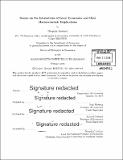Essays on the interactions of local economies and their macroeconomic implications
Author(s)
Howard, Gregory (Gregory Liang)
DownloadFull printable version (12.13Mb)
Other Contributors
Massachusetts Institute of Technology. Department of Economics.
Advisor
Iván Werning and Arnaud Costinot.
Terms of use
Metadata
Show full item recordAbstract
This thesis consists of three chapters about the spatial aspects of macroeconomics. Chapter 1 argues that local labor demand shocks are amplified by migration. I document that within-U.S. migration causes a large reduction in the unemployment rate of the receiving city, over several years. To establish the causal effect of inmigration, I construct a plausibly exogenous shock by using the outmigration of other places and predicting its destination based on historical patterns. Next, I document that the increase in the demand for housing explains the boom, through two channels. The construction channel occurs because housing is a durable good: hence there is a surge in the number of new houses and construction jobs. The house price channel occurs because the migrants' housing demand drives up prices, leading to increased borrowing and higher non-tradable labor demand. Last, I estimate that these effects imply that endogenous migration amplifies other shocks by 20 percent. Chapter 2, which is joint with Jack Liebersohn, estimates that between 20 and 40 percent of the overall rise in real house prices during the 2000-2006 U.S. housing boom can be attributed to an increase in the relative desirability of inelastic-housing-supply areas. First, we show local housing demand is significantly driven by population changes and changing relative desirability. We develop a theory for why an increase in the relative desirability of inelastic areas would raise house prices nationally. Finally, we quantify the total effect by creating a new measure of housing supply elasticity that covers the entire United States. We show that the decline in manufacturing and the fall in interest rates both played an important role through this geography channel. Chapter 3 documents that shifts in the geographic distribution of economic activity are more frequent around recessions. This effect is more pronounced in professions with greater nominal wage rigidity. As a possible explanation, I develop a new mechanism for equilibrium switching during recessions in a model of agglomeration using downwardly sticky wages. In a dynamic setting, the model requires a sufficiently large shock to switch equilibria. Within the model, place-specific time-specific firm subsidies can be welfare enhancing.
Description
Thesis: Ph. D., Massachusetts Institute of Technology, Department of Economics, 2018. Cataloged from PDF version of thesis. Includes bibliographical references (pages 107-114).
Date issued
2018Department
Massachusetts Institute of Technology. Department of EconomicsPublisher
Massachusetts Institute of Technology
Keywords
Economics.